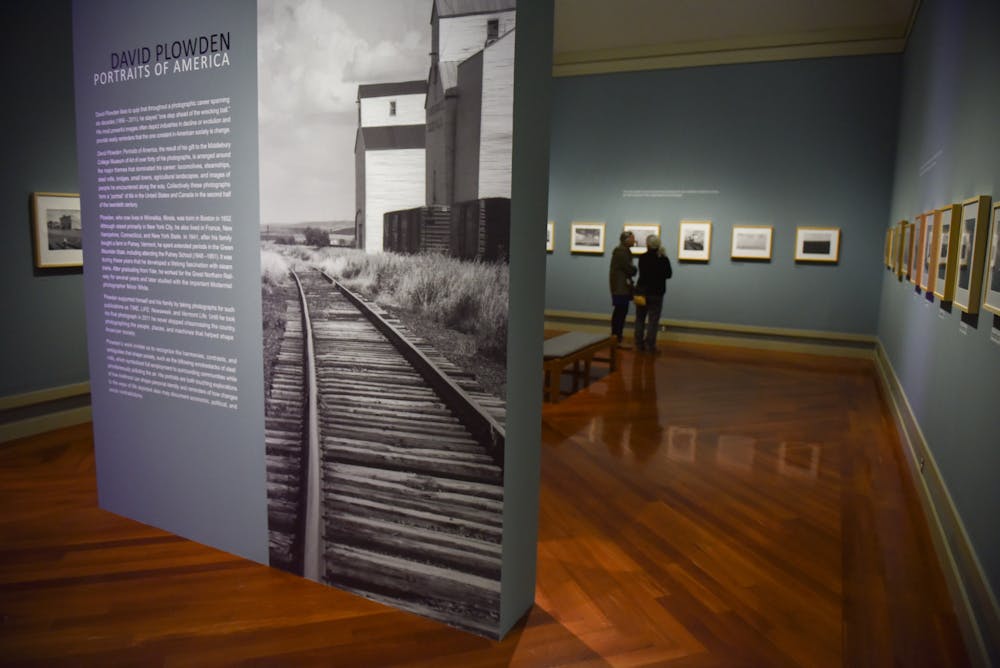Staff, students and faculty recently gathered at a reception on Thursday, Feb. 22 to celebrate the opening of The Middlebury Museum of Art’s two new spring exhibitions: “David Plowden: Portraits of America” and “Derrick Adams: Sanctuary.” Both exhibitions will run until April 14, offering intimate looks at life in America.
“Portraits of America” presents the work of David Plowden, a renowned documentary photographer born in Boston during the Great Depression. Each uniformly sized black-and-white photograph offers a piercing glimpse of the people, places and infrastructure that defined life in the United States and Canada in the mid-twentieth century.
Plowden’s photographs are organized thematically, grouped by the subject matter they depict. While the presentation is consistent across the photographs, the images of industrial and agricultural landscapes, from up-close physical portraits to snapshots of rolling fields and locomotives, show a society dominated by change.
One wall bears a powerful quote from Plowden: “All across America we have left abandoned, like carcasses after the feast, that which only yesterday was state of the art invention.”
The exhibition was curated by former Chief Curator and Director of Engagement, Diversity, Equity, and Inclusion at the college museum Jason Vrooman ’03, who now serves as the Director of Education at the Shelburne Museum.
In a thought-provoking juxtaposition to Plowden’s work, Adams’ “Sanctuary” features colorful mixed media works that leap off the gallery’s walls. A contemporary artist and performer based in Brooklyn, NY, Adams was inspired by “The Negro Motorist Green Book,” which was published annually from 1936 to 1967 by travel writer Victor Hugo Green. The book was a guide for Black American travelers seeking to find food, lodging and entertainment during a time when leisure activities like going on a road trip were difficult to navigate due to discrimination and segregation.
“Sanctuary” was curated by Dexter Wimberly and Derrick Adams Studio, which was run by Adams himself.
Nostalgic neon business signs fill the room with a warm glow, while a trumpet melody created in collaboration with musician Dave Guy adds to the atmosphere of the exhibition. At the center of the room is the sculpture “The Road: Keep Your Head Down and Your Eyes Open,” which depicts several fabric caps on wheels traveling across a raised road.
The toylike cars travel through large collaged excerpts of pages from “The Green Book.” The whimsical nature of the sculpture contrasts with its instructional title, reminding the viewer of the harsh reality at hand.
Throughout his exhibit, Adams addresses the theme that “driving while black” is a politically charged act, both historically and in our contemporary landscape. His multi-media works deconstruct our built environment and are punctuated by “beacons,” small concrete sculptures of houses that exude light and communicate the theme of seeking sanctuary.
The dialogue between the two exhibits is palpable, particularly in the monochromatically colored portraits of Black American travelers that hang near the doorway which transitions between Adam’s exhibit and Plowden’s.
The differences between their portraits highlight their distinct approaches to the past. Plowden, born in 1932, has crisscrossed the country to give the viewer hauntingly frozen moments in time from an America that is vanishing. His photographs, which feel like historic artifacts, are structural in nature, which contrasts with the fragile existence of the landscapes he portrays.
Contemporary artist Adams in comparison renegotiates and rebuilds the past through light, color, shape and sound, highlighting its relevance to our present. Addressing a complex history, his works communicate the perseverance of Black America and the fundamental desire to seek happiness.
Together, “Portraits of America” and “Sanctuary” offer distinctive but complementary conceptualizations of life in America in the twentieth century, and how the past informs present society.




